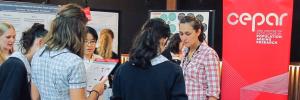Applications for the 2020 round of CEPAR PhD Supplementary Scholarships are now open and will close on 15 November 2019.
You are here
News

In September, three CEPAR researchers based at the UNSW Sydney node, Inka Eberhardt and Drs Mengyi Xu and Héloïse Labit Hardy, participated in the Girls Do the Maths Day, hosted by the UNSW School of Mathematics and Statistics.

CEPAR Chief Investigator Professor Peter McDonald AM has been appointed to the Research Committee of the Scanlon Foundation’s Institute for Applied Social Cohesion Research.

CEPAR researchers have been recognised with the Best Paper Award in the IAA Section Colloquium 2019 by the Pensions, Benefits and Social Security Section (PBSS) of the International Actuarial Association (IAA).

Within the lifetime of Australia’s millennials, the occurrence of heatwaves will triple and they will be longer leading to increased deaths among the nation’s elderly, an Actuaries Institute Dialogue paper, co-authored by CEPAR Senior Research Fellow Rafal Chomik and CEPAR Associate Investigator Ramona Meyricke, on the widespread impacts of climate change has found.

New guidelines, co-authored by CEPAR Deputy Director Kaarin Anstey and CEPAR Associate Investigator Ruth Peters, have been issued for Australian GPs that could help reduce dementia rates in Australia.

